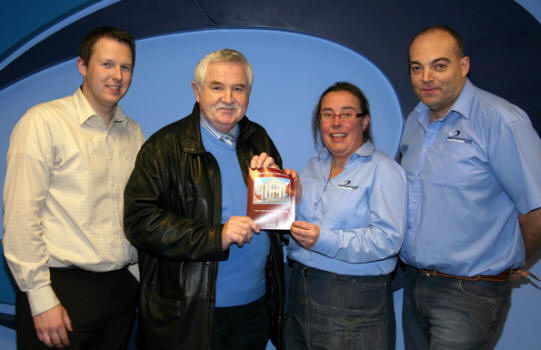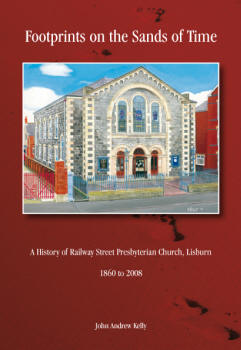|
A History of Railway Street Presbyterian Church, Lisburn
1860 to 2008
 |
 |
|
At the handover of the final copy of the book
are L to R: Andrew Smyth - Studio Manager, John Kelly,
Yvonne Campbell - Designer and
Adrian Glenn - Managing Director of Impression
Print and Design. |
Front cover of the book.
|
A book written by local churches correspondent John Kelly
entitled 'Footprints on the Sands of Time - A History of
Railway Street Presbyterian Church, Lisburn 1860 to 2008'
will be officially launched by former Moderator, The Very
Rev Dr Howard Cromie on Thursday 4th December at 7.30pm in
the church hall. Due to substantial sponsorship, the book,
an ideal Christmas present, will be available for purchase
in December at a very affordable price of just �5 in Smyth Pattersons and in local bookshops. Special guests at the
launch will include The Rt Rev Dr Donald Patton, Moderator
of the General Assembly, Lisburn Mayor Councillor Ronnie
Crawford, Lagan Valley MP Jeffrey Donaldson, Lisburn MLA's,
past Mayors and representatives from the Presbyterian
Historical Society and Lisburn Museum.
The book, the result of nearly four years research, charts
the history of Railway Street Presbyterian Church through
the ministry of its seven ministers. The chapters tell that,
following the Revival of 1859, services were held in a
temporary Meeting House in Castle Street until the present
church building was opened for worship in March 1864.
Recorded are the erection of the Railway Street National
Schools at the rear of the church; a manse and adjoining
house beside the church in 1869; a Lecture Hall in 1887; a
new manse at Fort Hill in 1900; the EMB hall at Hilden in
1912; the Brownlee Memorial Primary School and Teacher's
Residence in 1913; and the purchase of the present manse in
1961. The book also records major refurbishment including
the addition of side galleries in 1897; a new organ in 1908
and the present one in 1914; the renovation of the old
school house in 1952 when it became the Minor Hall, the
refurbishment of the Lecture Hall and the choir and pulpit
area of the Church in 1962 and the link area between the
Church and Minor Hall in 1978; a new extension to 31 Railway
Street in 1980; new stained glass windows in 1987 and the
complete refurbishment of the Lecture Hall in 1997. The book
concludes by recording that more recently the church was
re-roofed in 2007 and the church sanctuary completely
refurbished in 2008. A chapter entitled 'History in Glass,
Brass and Stone' shows the stained glass windows, plaques
and stone tablets erected at various times throughout the
years. The final two chapters record names and length of
service of ministers, assistant ministers, church office
bearers and leaders of organisations who left 'footprints on
the sands of time' since the formation of the congregation
in November 1860 leading up to its 150th anniversary in
November 2010.
Recommending this History to the widest possible readership,
The Very Rev Dr Howard Cromie says, 'We are deeply indebted
to the author, John Kelly, for the graphic way in which he
has recorded the rich and varied story of Railway Street
congregation. His careful research and skilful use of
primary material sets the scene in the social and religious
context of the wider community. Railway Street congregation
has played a notable part in the growth and development of
Lisburn from being a relatively quiet market town to
becoming a throbbing city. In every successive generation
God has richly blessed the work and witness of the
congregation, so that as we remember all the way that the
Lord has led us, we can confidently trust Him to lead us on
into the days that are yet to be. We can say with Edward
Hayes Plumptre: Thy hand, O God, has guided Thy flock, from
age to age.'
05/11/2008
 |